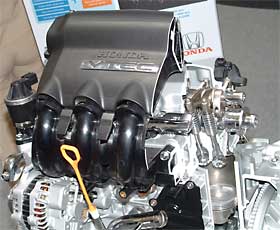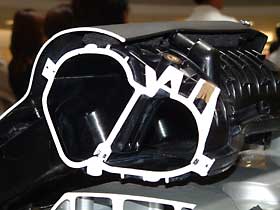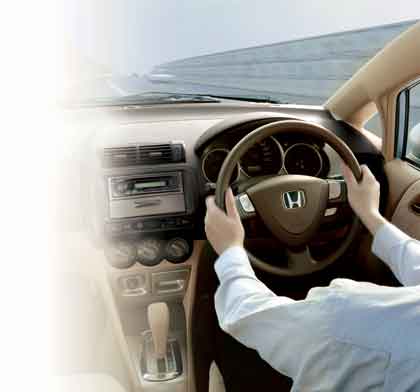Long overdue, I should have mentioned something about my 1st vehicle, Ford Escape. Bought in September 2001 and till today, have only clocked in 20,000+ km !!! Thanks to my frequent travels overseas, neglecting this baby many times ie. factory-delivered battery drained out on a long trip once... now I'll just disconnect the battery before leaving.
THE SPECIFICATIONS General Type : 5 door SUV
Engine type : Zetec 4 cylinder, 4 valves per cylinder
Displacement : 1988cc
Engine Transmission : Automatic 4-Speed
Drive Layout : F4 (front engine, 4WD)
Power (hp) : 130 @ 5400 rpm
Torque (Nm) : 183 @ 4500rpm
Fuel Consumption : n/a
Fuel Tank Capacity : 62 litres
Chassis Steering : Rack-and-pinion with power assistance
Suspension : Front MacPherson Strut Rear multi-link
Brakes : Front ventilated disc, rear drums, ABS, EBD (electronic brake force distribution)
Safety Features : Driver's and front passenger's airbags.
Others Passive anti-theft system with rolling code containing 72 quadrillion possible combinations.
Dimensions Curb Weight : 1470kg
Length : 4415mm
Wheelbase : 2620mm
Width : 1825mm
Height : 1770mm
Wheel : 15 inch alloy
Tyre : 225/70 R15
Distributor Ford Malaysia Sdn Bhd
Email: rho@ford.com
Website: www.ford.com.my
Anyway, the following is a local review of the car as a heads-up :-
Tuesday, April 10, 2001
The Great Escape
By Paul Si
FORD has unveiled its vision of the future, and it has four-wheel-drive. The all-new Escape rolls in as the Telstar bows out, highlighting Ford Malaysia's move away from the traditional executive saloon and towards "lifestyle" vehicles.
"The 2.0 litre CKD (completely knocked down or locally-assembled) car segment is no longer viable in Malaysia," says Ford Malaysia managing director Richard Canny.
He cites figures - the 2.0l car market now accounts for only 5.4% of total volume, and non-national makes' share of this thin slice is 25% (down from 54% in 1997). The total number of non-national cars in this class sold in 2000 was 3,879, which means even a market share of 20% would add up to merely 700 to 800 cars a year.
At the same time, the passenger vehicle segment is fragmenting rapidly. Instead of just saloons, customers can now choose from among SUVs (sport utility vehicles), MUVs (multi-utility), MPVs (multi-purpose)s, MAVs (multi-activity), and PPVs (seriously, there is such a thing, and the acronym stands for 'plenty of people vehicle').
Anyone who has doubts as to which way the trend is heading has only to count the proportion of new Honda CR-Vs to Accords.
Hence, the Escape takes over as Ford's top-of-the-line model for locally-assembled products.
“Ford studied customer lifestyles, needs and tastes in everything from cars to trucks to clothes when putting the Escape design renderings on paper. We believe this has created the ultimate blend – a tough SUV that will suit active and urban lifestyles”, said Canny.
The phenomenally successful Ranger was Ford's first crossover product (from commercial to dual use) in Malaysia, said Canny, and the Escape would be their next crossover, from the sedan to the compact SUV.
Incidentally, Malaysia is the first country in Asean to assemble the Escape, in line with Ford's plans to capitalise on global consumer trend towards compact SUVs.
After letting a bunch of motoring writers loose on the East Coast last week with a fleet of six shiny Escapes to play with, Ford Malaysia personnel were on hand to take questions. How much will it cost, when will it be available, what colours, the usual stuff. But these were asked by a couple of journalists who were impressed enough to want to become customers.
Initial impressions are nearly all good. The Escape looks great - beautifully proportioned, clean lines and an overall macho air inherited from its bigger Built-Ford-Tough brethren like the Explorer, Expedition and Excursion. The test units were brought in completely built up (CBU) with bumpers and protective side panels in two shades of grey but Ford Malaysia is mulling whether the locally-assembled version should have these components painted the same colour as the rest of the vehicle.
Malaysians already familiar with the spaciousness of the Honda CR-V will not be surprised to find that the Escape is even more roomy, since Ford is coming to the compact SUV party relatively late, and has the CR-V as well as Toyota's RAV4 for comparison when drawing up the specifications. Escape's designers have achieved a best-in-class interior in terms of cabin space for occupants as well as luggage.
But the best part of the Escape is the way it handles on the road. This is the Focus of compact SUVs, with a stiff chassis mated to a well sorted out suspension and a precise rack-and-pinion steering system.
The supple springs soaked up bumps and holes in the trunk roads from Kelantan to Terengganu and Pahang with ease, leaving drivers and passengers surprisingly relaxed and fatigue-free after hours of travelling.
When charging hard into corners, the vehicle's higher centre of gravity will cause it to roll more than a car but it loads up progressively and predictably. The steering's accuracy and feel will be a revelation for many who believe that only sporty sedans and hatchbacks can be flung into sweeping bends with gusto.
Describing the Escape as a taller Focus with four-wheel-drive would not be too far off since it is powered by the Zetec 2.0l engine which is also used in the high end model of the multi-award-winning car.
The alloy 16-valve engine produces its maximum power of 134ps at 5,400 rpm and peak torque of 185Nm at 4,500rpm. It is well balanced and smooth in all driving conditions, which should be no surprise as the output matches the rule of thumb which states that an ideal petrol engine is optimised when its maximum power, measured in horsepower, is the same or close to the torque, measured in pound-feet. For the Zetec 2.0l, the figures are 132 and 136 respectively.
The one component that prevents the Escape's drivetrain from receiving full marks is the four-speed auto gearbox. Its operation and gear changes are smooth enough but the ratios are not ideal, with a fairly big gap between second and third gears. Under certain conditions, such as climbing a steep hill or trying to overtake at high speed, the third is too high while second is too low. This hole results in the Escape alternately struggling in the higher gear and revving hard in the lower. Having said that, the package is good enough most of the time.
The transmission shift lever is mounted on the steering to free up space for the centre console and storage box (it is huge) but I found the spindly arm less user-friendly the conventional floor shifter. However, as an automatic, it will probably be left in D most of the time anyway and so should not be too much of an issue.
The drive system is Ford's Control Trac II. Under most conditions, all torque is channelled to the front and the vehicle behaves like any front wheel-drive, enjoying the tradional good fuel economy of a FWD. The driver-friendly system automatically proportions more torque to the rear wheels when the front wheels begin to slip. The advantage of this advanced system is that it requires no intervention from the driver, who most likely will not even notice any changes.
For more adverse driving conditions, Escape has a 4WD lock-up feature that enhances performance when driving off-road or on especially treacherous or slippery surfaces. The lock-up feature is a seamless system that can be smoothly engaged, while the vehicle is moving, with the simple push of a button to the "4x4 Lock" position.
The advanced system is comparable to the "4x4 High" position found in rear-wheel-drive 4WDs. When engaged, it distributes torque equally between the front and rear wheels.
The 4WD system, jointly developed by Ford, Mazda and Dana Corporation, was designed so that more than 90% of customers more than 90% of the time could leave the Escape in the "4x4 auto" setting and just forget about it while the "4X4 Lock" takes care of the rest.
For the technically-inclined, one of the key parts of the system is a power takeoff unit (PTO) that attaches to the transmission. The PTO is a series of gears that transfers power to the rear axle through a two-piece drive shaft – a design that allowed engineers to have a lower floor without sacrificing passenger roominess or cargo space. The two-piece drive shaft also reduces noise and vibration in the vehicle.
The "brain" of the 4WD system is a rotary blade coupling (RBC) that governs the front/rear power proportioning. Pushing the button on the instrument panel to the "4x4 Lock" position automatically activates a solenoid to lock the RBC for a full-time 50/50 power split between the front and rear axles. This setting is not recommended on dry roads because it can cause some binding in the driveline during tight turns.
The RBC is located between the end of the drive shaft and the rear axle differential. It contains a clutch pack and hydraulic pump. The system can detect differences in the rotational speed of the front and rear wheels. As soon as any slippage is detected, the hydraulic pump generates pressure to engage the clutch pack and redirect power to the rear wheels.
To put all these to the test, we took the Escapes along a logging trail which led to a river and ended up having a splashing good time playing in the water. There was no perceptible difference in the vehicle's behaviour whether it was in 4X4 Auto or Lock, the reason for which became apparent when a Nissan Sunny and a Kancil passed by on the same track! The track had just too much traction for the system to shift torque around.
The front suspension features MacPherson struts, which attach to rearward facing L-shaped lower control arms for lateral stiffness and road impact isolation. The springs and shocks are separately mounted to a dual-path upper strut mount, further helping to isolate shock forces that would otherwise hamper suspension tuning and ride qualities. The rear suspension uses a semi-trailing arm with two lateral links and coil springs located between the trailing arm and the body, conceptually similar to the independent rear suspensions used in some sport sedans.
The suspension combines with the wide track (1,550mm front, 1,530mm rear) to give the Escape a wide, almost crouching, stance that accounts for its confidence in corners.
The rack-and-pinion steering gear is mounted to a cross member. To increase rigidity and produce a tighter, more responsive steering feel, the steering gear features widely spaced mounting locations.
The Escape come with anti-lock brakes (ABS) and electronic brake force distribution (EBD), which registers the relative speeds of the front and rear wheels and applies brake pressure accordingly.
Initial doubts about the rear brakes being drums were soon dispelled after a successful evasive and braking manoeuvre to avoid a straying kid (that's a young goat, not a child) on a rural road in Pahang, and a couple more close shaves with oncoming traffic. Those brakes work, and work very well indeed.
If they prove to be insufficient, the Escape protects its occupants with two airbags (driver and front passenger) as well as seatbelt pre-tensioners and anti-intrusion bars in the doors.
Security is an issue that Ford has paid close attention to, given the Ranger's popularity with thieves, as well as that of the Honda CR-V. The Escape's passive anti-theft system (PATS) engine immobiliser system is a standard feature on the Escape for added security. This rolling-code keyless entry system changes the code each time the transmitter is operated. With a staggering 72 quadillion combinations (that's 72 million billion, or 72,000,000,000,000,000), any thief who gets it right probably deserves to get away with it.
Without the proper key, the vehicle cannot be started. If an attempt is made to start the engine using a key other than the correct one, the PATS immobiliser system disables the ignition system, rendering the engine unusable. Challenge-and-response technology makes it extremely difficult to duplicate the key.
Cost of ownership has also been taken into account, and Ford claims that Escape's 10,000km service interval and lower prices for parts will mean savings of over RM3,390 (RM1,897.50 for Escape, RM5,290.20 for rival) over a five-year period, compared with its nearest competitor.
Escape demonstrators will arrive in Ford showrooms on April 23, and the 38 dealers nationwide will start taking orders the same day. Work on Job #1, the first locally-assembled unit, will commence in June and the first delivery to customers will begin in August.
Oh, the price. That's not finalised but Ford promises it will be below RM140,000, on the road, without insurance.















